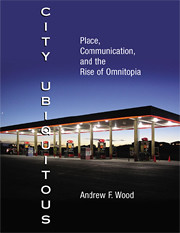Andrew Wood is an associate professor in communication studies at San Jose State University. He’s also a dyed-in-the-wool roadie.
 He’s written two books about two-lane highways, “Motel America” and “Road Trip America.” His Motel Americana site is an excellent thumbnail guide to vintage lodging. And Wood’s blog, Woodland Shoppers Paradise, has become a catch-all for his hobbies, including the media, Internet and roadside culture.
He’s written two books about two-lane highways, “Motel America” and “Road Trip America.” His Motel Americana site is an excellent thumbnail guide to vintage lodging. And Wood’s blog, Woodland Shoppers Paradise, has become a catch-all for his hobbies, including the media, Internet and roadside culture.
A few months ago, Wood published “City Ubiquitous” (paperback, $24.95, 214 pages, Hampton Press). Subtitled “Place, Communication, and the Rise of Omnitopia,” Wood explained in an e-mail:
It’s a scholarly book that is nonetheless meant to be accessible to a wider audience. The basic thesis is this:
Today’s melding of place and media threatens our ability to experience meaningful human interaction. City Ubiquitous explains how this phenomenon emerged, tours some of its exemplar sites, and offers a way out of omnitopia, back to a world worthy of being called real.
Perhaps the term “omnitopia” needs more clarification. Here’s Wood’s explanation:
Omnitopia enacts a structural and perceptual enclave whose apparently distinct locales convey inhabitants to a singular place. […] Think of it this way: When you can flow from place to place, experiencing it all as one vast interior, cocooned in your own bubble, interacting with other people and natural parts of the world only as a series of objects, you’re in omnitopia.
In his book, Wood traces this cocooning to the World Fairs’ visions of the future (including the influential Futurama in 1939). Designers’ desire for a utopia that is free of risk, exudes comfort and is detached from the outside world has obviously influenced modern-day hotels, shopping malls, interstate highways, airports, casinos … even cell phones and iPods.
“City Ubiquitous” essentially begins when he recounts his accepting a challenge to travel coast-to-coast by car — more than 3,000 miles — without speaking more than 10 words per day to other people. As it turned out, he spoke even less, thanks to the Internet and electronic kiosks that allowed him to order meals and make hotel reservations with little human interaction. A little solitude during a road trip is a good thing. But 108 consecutive hours of it must have been like a hell on Earth.
And thus begins the examination about how designers, businesses and technology have helped cocoon ourselves even more into our own private, contented universes.
The chapter about hotels is particularly fascinating. Wood traces how the humble but hospitable roadside motel evolved into massive complexes that allow guests to never leave its tendrils. He cites in particular the Atlanta Hyatt, which connects other businesses above street level with a series of enclosed walkways that resemble hamster tunnels. Local black residents derisively call them “honkey tubes.”
Ironically, the Holiday Inn motel chain, which blazed the trail to many such designs, is experimenting with prototypes that hearken back to its roots with a retro stylings and Kem’s Cafe diners that serve comfort food.
One of the most bizarre parts of the book is where Wood explores the massive West Edmonton Mall, which is bigger than the much-ballyhooed Mall of America and provides a complete detachment from Canada’s elements and the outside world in general. There, in the West West Shooting Centre, Wood shoots paper-target zombies with a rented H&K USC semi-automatic carbine, as if he were re-creating a scene from “Dawn of the Dead.”
Wood’s recountings of these personal experiences are amusing and perceptive. I wished there were more of them in the parts of the book that got bogged down in more scholarly musings. Sentences such as “Enacting enclavic rhetoric, omnitopia produces a convincing simulacrum of the ‘outside world’ that enacts perceptual and structural barriers between tourist-corporate enclaves and the messy and dangerous domains beyond” may be stimulating to fellow professors. But this college-educated roadie found these portions of “City Ubiquitous” to be a tough slog through a thicket of what my father would call “fifteen-dollar words.”
Happily, Wood finds a sort of reconciliation with omnitopia through Route 66. He praises mom-and-pop motels such as the Blue Swallow Motel in Tucumcari, N.M., which “offer the potential for a moment of history where all else is ceaseless movement.”
And he finds comfort in the fast-decaying remains of John’s Modern Cabins near Arlington, Mo.:
“We need the ruins even if we dismiss them publicly, to affirm the endurance of memory, the temporary nature of our lives, the fleeting moments in which we can choose who we are. […] Outside omnitopia, we return to ruins as anchors to a world we call real.”
Even though Wood is an enthusiastic user of such omnitopian products as the Internet and the iPod, he advises us to slow down and smell the roses — and, I suppose, the rotting wood of long-neglected tourist cabins. I’m sure he’d concur with roadies who often say, “Life begins at the off-ramp.”
(Note: Excerpts of Wood’s book can be downloaded here.)
LOL! I vacation once a year at the Atlanta Hyatt that Wood references. He’s right — there are some folks who never breath outside air all weekend. They walk from building to building in those tubes. I’ve seen folks who live in their detached “bubble” — it’s a strange existence to me. But seems to be getting more and more commonplace.
Not sure I could slog through the rhetoric of the book *yawn* but enjoyed your blog about it.